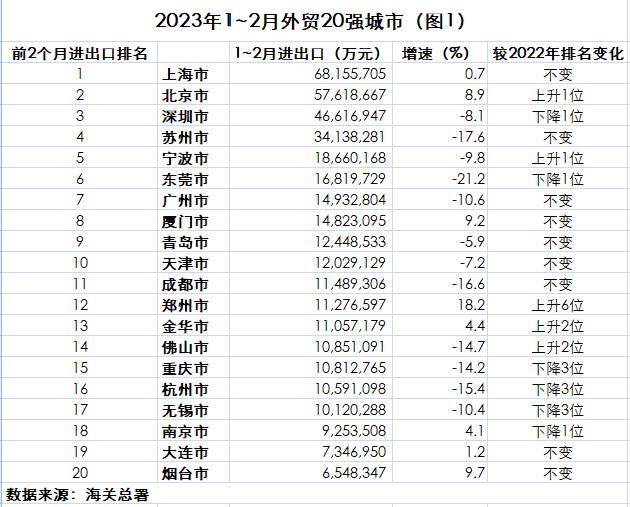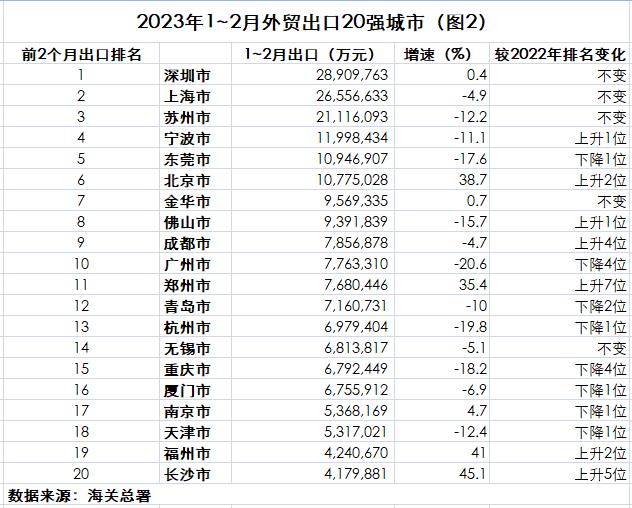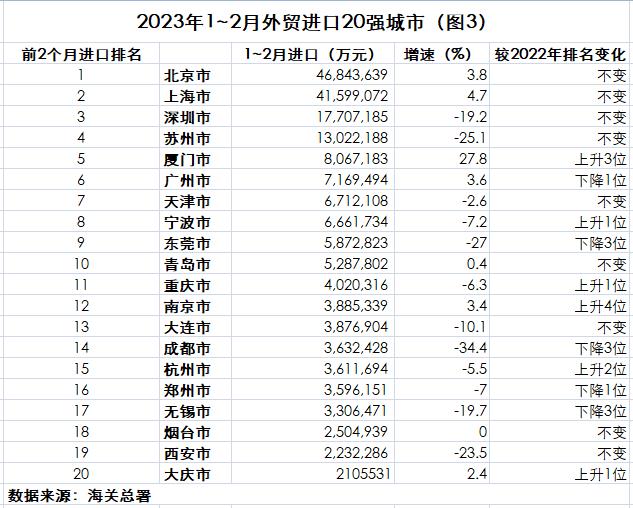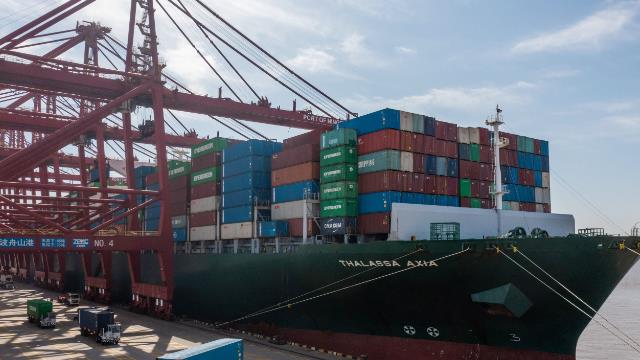In January and February, the top 20 foreign trade cities were released, and Beijing ranked second, and Zhengzhou’s export approached Guangzhou.
Organizing a delegation of 1,100 people to go south to Guangzhou and Hong Kong to participate in the exhibition to open up the market, winning 3,000 square meters and 200 booths, and staying in three hotels for one month in a down-to-earth manner. This is the plan of a large foreign trade company in Ningbo, Zhejiang Province in April, and it is also a microcosm of the efforts of the "foreign trade city" in the severe situation.
Faced with the challenges of the global economic downturn and shrinking external demand, Ningbo, which set a precedent for the first commercial charter flight to the sea as early as last July, has never stopped, and a large number of private foreign trade enterprises have also shown a strong will to open up the market.
As the head of the first commercial charter group in China, Fei Jianming, director of the Foreign Trade Promotion Department of Ningbo Municipal Bureau of Commerce, told CBN that the number of exhibitors and booths who signed up for the Canton Fair this year exceeded that before the epidemic and reached a record high. "From the perspective of corporate initiative, we are still quite confident." He revealed that many overseas customers have clearly expressed their eagerness to come to China, and the two sides agreed to meet and discuss in the Canton Fair and other offline.
The initiative of front-line personnel and their feelings about the market are mutually confirmed by the data on the surface.
According to the data of the General Administration of Customs, in terms of US dollars, China’s import and export volume in February exceeded US$ 411.2 billion, up 1.3% year-on-year, and China’s imports in February reached US$ 197 billion, up 4.2% year-on-year, which both ended the downward trend of year-on-year growth for four consecutive months. Although February’s exports fell by 1.3% year-on-year to $214 billion, the growth rate was still negative, but it was significantly narrower than the decline in the past three months, with a drop of 10.5% in January.
Although the import and export data in the first two months of this year declined year-on-year, Ningbo, which is the "sixth foreign trade city in China", has been squeezed into the top five in the foreign trade rankings of China cities, and the ranking of exports and imports has also increased by one place compared with the whole year of 2022.
In addition to Ningbo, CBN combed the import and export data of major cities in China in the first two months of this year, and compared it with the ranking in 2022, and found changes in the foreign trade performance of several cities. For example, Beijing’s import and export scale surpassed Shenzhen to rank second; Zhengzhou rose by six places, and its exports even approached Guangzhou, surpassing Qingdao, Hangzhou, Wuxi, Xiamen, Nanjing, Tianjin and other cities to climb to the 11th place.
The trends and reasons of the changes in the foreign trade rankings of these cities can, to a certain extent, provide corresponding reference for the next stable foreign trade and transformation and upgrading.
What changes have taken place in the ranking?
According to the list compiled by CBN, more than half of the top 20 cities in terms of import and export scale in the first two months of this year are located in the Yangtze River Delta and Pearl River Delta regions; Chengdu, Zhengzhou and Chongqing are also among the top 20. Compared with 2022, the top 20 cities are still old players and have no new faces, but 11 of them have adjusted their rankings.

With a positive growth of 0.7%, Shanghai continues to be the champion of the national import and export scale. Among the top three, Beijing overtook Shenzhen by 8.9% year-on-year, while Shenzhen ranked third by 8.1% year-on-year, with a positive and negative growth rate leading to a gap of more than 110 billion yuan.
Suzhou continues to rank fourth. Ningbo, which squeezed into the top five, switched places with Dongguan. Although their own scale has declined compared with last year, compared with Ningbo’s performance of 9.8% year-on-year, Dongguan’s decline is even more severe — — It decreased by 21.2% year-on-year.
Guangzhou, Xiamen, Qingdao, Tianjin and Chengdu followed Dongguan in the same ranking.
After Chengdu, the biggest change is Zhengzhou, which has risen six places in the ranking of urban import and export scale due to the positive growth of 18.2% year-on-year; After that, Jinhua and Foshan both rose by two places; Chongqing, Hangzhou and Wuxi all dropped by three places due to double-digit year-on-year decline; Even though the import and export of Nanjing increased by 4.1% year-on-year, it still fell by one place in the ranking; While the ranking of Dalian and Yantai remains unchanged.
In terms of the growth rate of import and export, eight cities in the top 20 showed positive growth and outperformed the national growth rate (-0.8%). Among them, Zhengzhou, the fastest growing city, increased by 18.2%, while the other 12 cities experienced negative growth year-on-year, with the most serious decline in Dongguan.

As far as the export ranking in the first two months of this year is concerned, the top three remain stable, Shenzhen continues to sit firmly first, and Shanghai and Suzhou rank second and third respectively; Ningbo also moved to the fourth place with Dongguan; Beijing rose two places to sixth place; Jinhua, which includes Yiwu, the "commodity capital of the world", continues to rank seventh.
In addition to Ningbo and Beijing, Foshan, Chengdu, Zhengzhou, Fuzhou and Changsha are among the top 20 export cities. The most significant increase is Zhengzhou — — Its exports rose by seven places with a growth rate of 35.4%, approaching Guangzhou, which also became the main driving force for its double-digit growth in imports and exports.
Compared with the ranking of import and export, the ranking of export has changed greatly, and 15 cities in the top 20 have been adjusted, which shows the fierce competition.
In terms of export growth rate, seven cities in the top 20 showed positive growth, and only five cities outperformed the national growth rate (0.9%). Among them, Beijing, Zhengzhou, Fuzhou and Changsha all showed rapid growth, with year-on-year growth of 38.7%, 35.4%, 41% and 45.1% respectively. 14 cities are declining; Guangzhou, Hangzhou, Chongqing, Dongguan, Foshan, and Tianjin, respectively, decreased by 20.6%, 19.8%, 18.2%, 17.6%, 15.7%, and 12.4%.

Judging from the import ranking in the first two months of this year, the top four remain unchanged, still Beijing, Shanghai, Shenzhen and Suzhou. Xiamen rose three places in the ranking with a year-on-year growth rate of 27.8%; Guangzhou’s imports increased by 3.6% year-on-year, but still fell by one place in the ranking; Ningbo’s imports, like exports and imports and exports, have all increased by one place; Dongguan dropped by 3 places with a decline of 27%; Chongqing, Nanjing and Hangzhou rose by 1, 4 and 2 respectively.
In terms of import growth rate, only 7 cities in the top 20 showed positive growth, and 12 cities decreased year-on-year, among which Xiamen had the largest growth and Chengdu had the largest decline, with a decrease of 34.4%. In addition to Chengdu, the imports of Dongguan, Suzhou, Xi ‘an, Wuxi and Shenzhen also showed double-digit declines, down 27%, 25.1%, 23.5%, 19.7% and 19.2% year-on-year. Imports of 9 cities in the top 20 outperformed the national growth rate.
Beijing:Exports of new energy and other products surged.
In the top 20 rankings of foreign trade import and export, Beijing, Ningbo, Zhengzhou, Jinhua and Foshan have all improved.
For Beijing, the main reason for overtaking Shenzhen is not only the objective factors that lead to a large decline in Shenzhen’s foreign trade due to the downward trend of the general environment, but also the strength that its own import and export, exports and imports have maintained positive growth year-on-year. For Beijing, as a national import champion, imports accounted for more than 61% of its foreign trade scale, and continued to grow by 3.8% in the first two months of this year; At the same time, exports with a year-on-year growth of 38.7% are also quite eye-catching, mainly driven by the growth of state-owned enterprises’ performance and the surge in exports of new energy products.
According to the data of Beijing Customs, in the first two months of this year, the import and export of state-owned enterprises in Beijing was 439.28 billion yuan, an increase of 16.3%. The import and export of private enterprises was 51.68 billion yuan, an increase of 12.8%. The main import and export trade modes in Beijing showed a growth trend in the first two months. With the landing of a series of pilot projects, the import and export of Beijing Bonded Zone increased greatly. Among them, the import and export of general trade was 494.3 billion yuan, an increase of 6.4%, accounting for 85.8% of the total import and export value of the region in the same period; The import and export of bonded logistics was 49.4 billion yuan, an increase of 33.9%, accounting for 8.6%; The import and export of processing trade was 23.64 billion yuan, up by 15.2%, accounting for 4.1%.
In terms of categories, new energy products that have become the "new kinetic energy" of China’s foreign trade exports have also surged several times in Beijing. In the first two months, Beijing exported solar cells, electric manned vehicles and lithium batteries totaling 1.98 billion yuan, an increase of 620%. Among them, solar cells were 1.17 billion yuan, an increase of 65.3 times; Electric manned vehicles were 460 million yuan, an increase of 177.1%; Lithium batteries reached 350 million yuan, an increase of 285.2%.
In addition to new energy products, the biomedical industry, which is more convenient in customs clearance and approval, is another contributor to Beijing’s foreign trade growth: in the first two months, Beijing imported and exported 18.18 billion yuan of life science and technology products, an increase of 18.8%. Among them, imports were 16.19 billion yuan, an increase of 37.3%. Imported medicines reached 20.08 billion yuan, up by 49%; The export of medical instruments and instruments was 1.01 billion yuan, an increase of 5.9%.
Ningbo: The Resilience of Private Cities
For Ningbo, although the import and export, export and import in the first two months decreased by 9.8%, 11.1% and 7.2% respectively compared with last year, it rose one place in the ranking neatly.
Unlike Beijing, Ningbo’s main foreign trade force is private enterprises. According to Ningbo Customs data, the import and export of private enterprises in Ningbo reached 136.85 billion yuan in the first two months, down 5.8% year-on-year, accounting for 73.3% of the city’s total import and export value, up 3.1 percentage points year-on-year; The import and export of state-owned enterprises increased by 7.4%, accounting for only 8.1%, an increase of 1.3 percentage points; The import and export of foreign-invested enterprises decreased by 27%, accounting for 18.5%, down by 4.4 percentage points.
Although it has declined year-on-year, the increasing proportion of private enterprises also shows the resilience of this private city. During the period when the European and American markets are shrinking, emerging and developing regions have become new bright spots. Among them, Ningbo’s import and export to ASEAN and Russia have increased by 1.4% and 74.8% respectively, and its import and export to countries along the Belt and Road Initiative, the Middle East and Central and Eastern Europe have increased by 9.7%, 9.3% and 11.6% respectively, and their proportions are also increasing.
Different from the growth of major import and export trade modes in Beijing, the challenges faced by Ningbo look more severe. The import and export of general trade, which accounts for 90.6% of the city’s total foreign trade, decreased by 9.4%, and the processing trade, which accounts for about 5.3%, also declined by 26.6%, but the bonded logistics, which accounts for 4%, increased significantly, with an increase of 16.5%.
However, general trade, which accounts for more than 90%, has also given Ningbo greater ability to resist risks. In contrast, in Dongguan, where the import and export decreased by 21.2%, the general trade accounted for about 44%, processing trade accounted for about 30% and bonded logistics trade accounted for 23% in the first two months of this year, which decreased by 19.36%, 26.96% and 19.71% respectively, among which the processing trade declined the most seriously and was inevitably partially affected by industrial transfer.

In terms of categories, Ningbo continues to take mechanical and electrical products as the main export products, accounting for 57.7%. Although the export of mechanical and electrical products decreased by 11.2% year-on-year, the performance of green low-carbon products was outstanding, among which the export of electric manned vehicles, solar cells and lithium-ion batteries reached 2.15 billion yuan, 2.75 billion yuan and 1.63 billion yuan respectively, up by 142.3%, 6% and 114.1% year-on-year, with a total increase of 53.9% and a 2.3 percentage point increase. In addition, the export growth of some industrial products is also remarkable, such as air conditioners, automatic data processing equipment and their parts increased by 11.6% and 120.2% respectively.
Although Ningbo’s imports also showed a year-on-year decline, the magnitude was smaller than that of exports. While the import of major resource products declined, Ningbo’s imports of consumer goods increased rapidly in the first two months of this year, among which the imports of passenger cars, meat, edible aquatic products and edible oil were 1.89 billion, 630 million, 520 million and 2.15 billion respectively, increasing by 161.9%, 393.6%, 514% and 259.5% respectively.
Fu Xiao, president of Ningbo Academy of Social Sciences, Zhejiang Province, told CBN that the year-on-year growth rate of Ningbo’s foreign trade declined, but the ranking rose, which highlighted Ningbo’s grasp of market opportunities in a complex external environment. In addition to closely combining the changes in the international environment, we have launched a series of support policies to support foreign trade enterprises to increase exports to countries along the Belt and Road, Russia, Central and Eastern Europe and other places, and actively promote the "going out" of green manufacturing, including smart meters. In recent years, Ningbo has also made efforts to promote port development, trying to "make the port hard-core force stronger and build a strong international port".
Fei Jianming believes that Ningbo not only has port advantages, but also has a large number of small and medium-sized foreign trade enterprises due to the high proportion of general trade. "Half of the import and export volume of Ningbo Port is created by Ningbo enterprises." Such a foundation and environment have also gathered a large number of foreign trade talents in the local area, which has become the driving force to promote Ningbo’s foreign trade to stabilize its stock and find increments.
Zhengzhou is facing challenges in maintaining its stock, and Jinhua’s market procurement continues to exert its strength.
As a central city, why does Zhengzhou, which accounts for nearly 70% of its exports, rise so fast? In the first two months of this year, Zhengzhou’s imports and exports increased by 18.2% and 35.4% year-on-year, while imports fell by 7%.
Bai Ming, a member of the Academic Degrees Committee of the Ministry of Commerce, told CBN that Zhengzhou, like Ningbo, has a high industrial concentration and a large radiation radius. However, Zhengzhou’s greater characteristics lie in the airport economy and cross-border e-commerce, and the cross-border freight transportation advantages of airports and China-Europe trains are outstanding and the growth trend is strong.
However, Zhengzhou, which has been highly dependent on Foxconn’s exports for more than ten years, is facing the possible risk of capacity transfer and the pressure of market contraction, and whether it can hold its stock is facing great challenges — — According to media reports, Foxconn will invest 700 million US dollars in India to continue to expand its factory.
"Foxconn’s impact on Zhengzhou’s exports, the current data does not seem obvious, and the future may be unknown." Bai Ming said.
Jinhua and Foshan, which both rose two places in the import and export rankings, showed different development trends compared with their own vertical — — Jinhua’s import and export, export and import all maintained positive growth in the first two months of this year, increasing by 4.4%, 0.7% and 36.3% respectively, while Foshan decreased by 14.7%, 15.7% and 7.1% respectively.
Jinhua, which has been a leader in market procurement for a long time, also relied on the advantages of market procurement in the first two months of this year to boost the city’s exports by 3.2 percentage points, achieving exports of 56.51 billion yuan, an increase of 5.7%, accounting for more than 80% of the total value of market procurement exports in Zhejiang Province. Yiwu, which has gathered a large number of small and medium-sized micro-foreign trade enterprises, has also continuously consolidated the leading position of private enterprises in Jinhua — — In the first two months of this year, the total import and export value of private enterprises in Jinhua reached 108.91 billion yuan, accounting for 98.5% of the city. At the same time, the export of green low-carbon products is also good, among which the export of solar cells and electric vehicles increased by 40.4% and 3.2 times respectively.
According to Yiwu Customs data, in the first two months of this year, the total import and export value of Yiwu reached 79.19 billion yuan (accounting for more than 70% of Jinhua’s import and export), an increase of 7.4% over the previous year; Among them, the export was 72.90 billion yuan, a year-on-year increase of 6.7%; Imports reached 6.29 billion yuan, up 16.1% year-on-year. The growth rate is 12.2, 13.1 and 16.4 percentage points higher than that of the whole province respectively, and the import and export, export and import value account for 11.5%, 14.5% and 3.3% of the whole province respectively. Among them, trade with the EU increased by 20.5%, trade with the United States decreased by 7.8%, and imports and exports to countries along the Belt and Road increased by 8.2%. In addition, imports and exports to Saudi Arabia and Brazil increased by 47.3% and 25.8% respectively.
At the same time, Jinhua, which has made great efforts to develop imports by taking advantage of the basic advantages of export trade in recent years, has also achieved certain results. According to official data, in the first two months of this year, Jinhua imported 6.55 billion yuan, 3.73 billion yuan and 990 million yuan of unwrought copper and copper products, beauty cosmetics and toiletries, respectively, increasing by 1.2 times, 9.3% and 72.3% respectively, which together boosted the import growth of the whole city by 39.1 percentage points.
Shu Yuting, spokesperson of the Ministry of Commerce, said at a regular press conference on March 16 that the smooth start of foreign trade this year showed strong development resilience. On the one hand, the scale remained stable; On the other hand, the structure is continuously optimized. Private enterprises are more active, trade with emerging markets is closer, cross-border exchanges are smoother, and new kinetic energy of foreign trade is continuously released. Local governments and enterprises generally report that weakening external demand and declining orders are the biggest challenges facing China’s foreign trade this year. On the basis of extensive and in-depth research, the Ministry of Commerce is working with relevant departments to study the policy of stabilizing foreign trade and promote the stable scale and excellent structure of foreign trade according to the needs of local and enterprises.
"A large number of overseas customers are eager to come to China to participate in exhibitions and open up markets. China enterprises are also looking forward to obtaining orders and expanding trade through exhibitions." At the press conference on March 23, Shu Jueting also said that it is expected that the scale of exhibitions held in China throughout the year will increase significantly compared with the previous year.
With the resumption of offline economic and trade activities, such as the Consumer Expo to be held in Hainan in April and the Canton Fair to be held in Guangzhou, it will be the highlight of stabilizing foreign trade and increasing orders this year, and it is also expected to drive the import and export of various places to continue to pick up.